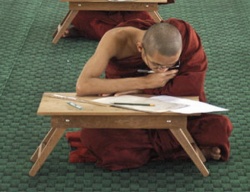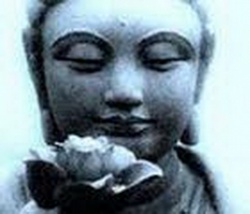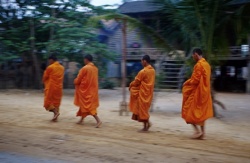The Five Sublime eyes
The Five Sublime eyes Likewise, the eye consciousness in the continuum of a person who abides on the level of the First Concentration pertains to the First Concentration. However, in the case of a person who abides in the Second Concentration or above, the eye consciousness does not pertain to the Second Concentration. because sense consciousnesses can only pertain either to the Desire Realm or to the First Concentration.
The reason for this is that sense consciousnesses ar e relatively coarse whereas awarenesses that pertain to the Second, Third, and Fourth Concentration Levels as well as to the Four Formless Levels are increasingly subtle. Therefore, the eye consciousness in the continua of those who abide in the Second Con centration and above necessarily pertains to the First Concentration. Panchen Sonam Drakpa supports this explanation with a passage from the eighth chapter of Vasubhandu's Abhidharmakosha ( Treasury of Manifest Knowledge ): In the second and so forth whatever body, eye, and Ear consciousnesses and the motivation for the revelatory There are, they are those included in the first.
These three lines are Vasubhandu's response to another person's debate. The other person says that, since there are no sense consciousnesses that pertain to the Second Concentration and above, it absurdly follows that a person who abides in the Second, Third, or Fourth Concentration is not able to see visual forms, hear sounds, or touch tangible objects. However, Vasubhandu replies that this absurdity does not ensue because eye consciousnesses, ear consciousnesses, and body consciousnesses in the continua of those who abide in the Second Concentration Abode and above, pertain to the First Concentration Level. Please note that only three sense consciousnesses are mentioned.
The reason for this is that there are no nose consciousnesses and tongue consciousnesses in the continua of beings who abide in any of the four Form Realms. There are no nose consciousnesses and tongue consciousnesses in the continua of beings who abide in those realms because there are no smells and tastes in those realms. Furthermore, sense consciousnesses cannot arise in dependence on sense powers that pertain to a level lower than themselves.
For example, an ey e consciousness that pertains to the First Concentration in the continuum of a person of the First Concentration cannot arise in dependence on a sense power that pertains to a level that is below the First Concentration, i.e. in dependence on a sense power that pertains to the Desire Realm. The reason for this is that sense powers that pertain to the Desire Realm are inferior to sense powers that pertain to the First Concentration. Therefore, sense consciousnesses arise either in dependence on sense powers that pertain to the same level or in dependence on sense powers that pertain to any Form Realm level above their own.
Eye consciousnesses that arise in dependence on eye sense powers that pertain to the same level are illustrated by the previously cited e xamples one, three, and four (Handout 14), whereas eye consciousnesses that arise in dependence on eye sense powers that pertain to a higher level are illustrated by examples two, five, and six. Moreover, sense powers that pertain to a lower level do not manifest in the continuum of a person who pertains to a higher level. Therefore, a sense power that pertains to, for instance, the First Concentration does not manifest and cause the arising of a sense consciousness in the continuum of a person who pertain s to the Second Concentration. The reason for this is that there is no need for a sense power that pertains to a lower level (an eye sense power that pertains to the First Concentration) when the person possesses a sense power that pertains to a superior level (an eye sense power that pertains to the Second Concentration). Vasubhandu says in the first chapter of his Abhidharmakosha ( Treasury of Manifest Knowledge ):
A lower eye (sense power does ] not (manifest) in a body [that pertains to a higher level ] Hence, sense powers only manifest in the continuum of a person who pertains to the same level (as the sense powers) or to a lower level. The case of an eye sense power that manifests in the continuum of a person who pertains to the same level is illustrat ed by the previously cited examples The Five Sublime eye s one, three, and four whereas an eye sense power that manifests in the continuum of a person who pertains to a lower level is illustrated by examples two, five, and six .
Also, sense objects that pertain to higher levels cannot be perceived in dependence on sense powers that pertain to lower levels. Therefore, a visual form that pertains to the First Concentration, for instance, cannot be perceived in dependence on an eye sense power that pertains to the Desire Realm. Vasubhandu says in the first chapter of his Abhidharmakosha ( Treasury of Manifest Knowledge ): Higher (visual) forms are not (perceived in dependence on] an eye (sense power that pertains to a lower level ] The First Dalai Lama Gyalwa Gedun Drup explains Vasubhandu's passage in his Clarifying the Path to Liberation (a commentary on the Abhidharmakosh a ): [A visual) form of a higher level is not the object of a lower eye (sense power) because a higher visual form is not perceived by [a lower eye sense power ] due to its subtleness . Hence, the object of a higher eye (sense power) is a form of its own level and of lower levels .
Thus, the first Dalai Lama explains that a visual form that pertains to a higher level cannot be perceived in dependence on an eye sense power that pertains to a lower level because visual forms that pertain to higher levels are too subtle for eye sense powers that pertain to lower levels. Therefore, only visual objects that pertain to the same or lower levels than an eye sense power can be perceived in dependence on that eye sense power. For instance, a visual object that pertains to the First Concentration can only be perceived in dependence on an eye sense power that pertains either to t he First, Second, Third, or Fourth Concentration.
It cannot be perceived in dependence on an eye sense power that pertains to the Desire Realm because a visual object that pertains to the First Concentration is too subtle for an eye sense power that pertai ns to the Desire Realm. Visual objects that pertain to the same level as their eye sense powers are illustrated by examples one, two, three, and five whereas visual objects that pertain to lower levels than their eye sense powers are illustrated by example s four and six.
Panchen Sonam Drakpa then explains that since the above cited passages from Vasubhandu's Abhidharmakosha generally describe sense powers, sense consciousnesses, and their objects by way of the examples of eye sense powers, eye consciousnesses, and their objects : visual forms , the passages need also to be applied to ear sense powers, ear consciousnesses, their objects sounds, and so forth. Thus, the passages could also read: A lower ear (sense power does ] not (manifest) in a body [that per tains to a higher level ] .
Higher sounds are not (perceived in dependence on] an ear (sense power that pertains to a lower level ] and so forth. 4. The demarcation of the five sublime eye s Gyaltsab je says in his Ornament of the Essence : A physical sublime ey e exists from the path of accumulation onwards, a celestial sublime eye from the path of preparation onwards , a sublime eye of wisdom from the meditative equipoise of the path of seeing onwards , a sublime eye of Dharma from the subsequent attainment of the path of seeing onwards, the similitude of the sublime eye of a Buddha from the eighth ground onwards, and the actual sublime eye of a Buddha from the Buddha ground onwards . Lama Tsongkhapa says in his Golden Rosary :
There is no fault in [asserting] that the celestial sublime eye is att ained on the path of accumulation . [Furthermore,] since it is said that the sublime eye of a Buddha is attained at the time of complete training on the seventh bhumi (Bodhisattva ground), the similitude of the sublime eye of a Buddha exists from the seventh bhumi onwards .


